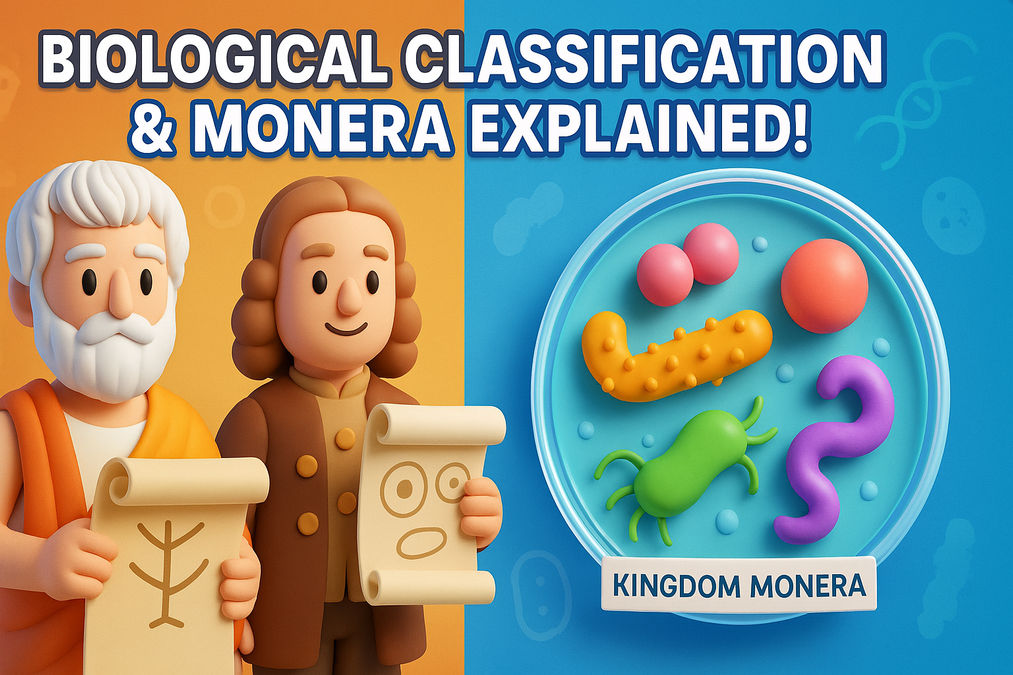
Explore the evolution of classification systems in biology and dive deep into Kingdom Monera, its types, and significance.
Table of Contents
Evolution of Classification Systems
Aristotle to Whittaker
The earliest classification system was proposed by Aristotle, grouping organisms based on visible traits. Later, Linnaeus developed the Two Kingdom system: Plantae and Animalia. This model proved inadequate as more organisms were discovered.
Whittaker's Five Kingdom Classification
In 1969, R.H. Whittaker proposed the Five Kingdom system: Monera, Protista, Fungi, Plantae, and Animalia. Criteria included cell structure, nutrition, reproduction, and phylogeny.
Kingdom Monera
Overview
Kingdom Monera includes prokaryotic, unicellular organisms like bacteria. These are the most primitive and abundant organisms on Earth, showing diverse shapes and metabolic strategies.
Types of Bacteria
- Coccus (spherical)
- Bacillus (rod-shaped)
- Spirillum (spiral)
- Vibrio (comma-shaped)
Archaebacteria
Characteristics
Archaebacteria are ancient bacteria found in extreme habitats like hot springs and salty lakes. Their unique cell wall composition allows them to survive in such conditions.
Examples
- Halophiles (salty areas)
- Thermoacidophiles (hot springs)
- Methanogens (ruminant guts – produce methane)
Eubacteria
Features
Known as “true bacteria”, eubacteria have rigid cell walls and may be motile with flagella. Cyanobacteria (blue-green algae) are photosynthetic and play roles in nitrogen fixation.
Importance
- Used in curd production
- Decomposers
- Fix nitrogen
- Pathogens (cholera, typhoid)
FAQs
Ans: Monera, Protista, Fungi, Plantae, Animalia.
Ans: R.H. Whittaker in 1969.
Ans: Unicellular prokaryotes like bacteria.
Ans: Archaebacteria that produce methane, found in ruminant guts.
Ans: Coccus, Bacillus, Spirillum, Vibrio.
Ans: Archaebacteria have unique cell walls and live in extreme conditions, while eubacteria have rigid cell walls and live in normal environments.
Ans: Organisms in Monera are prokaryotic, lacking a well-defined nucleus and membrane-bound organelles.
Ans: No, Monerans can be autotrophic (photosynthetic or chemosynthetic) or heterotrophic (saprophytic or parasitic).
Ans: Cyanobacteria, or blue-green algae, are photosynthetic eubacteria that fix nitrogen and are found in aquatic environments.
Ans: Heterocysts are specialized cells in cyanobacteria that help fix atmospheric nitrogen.
Ans: A flagellum is a whip-like structure that helps bacteria in locomotion.
Ans: Bacteria primarily reproduce by binary fission and also through spore formation and primitive DNA transfer.
Ans: Mycoplasmas are the smallest living cells that lack a cell wall and can survive without oxygen.
Ans: Cholera, typhoid, tetanus, and citrus canker are caused by different bacteria.
Ans: Classification helps in understanding relationships among organisms, organizing diversity, and making study easier and systematic.
